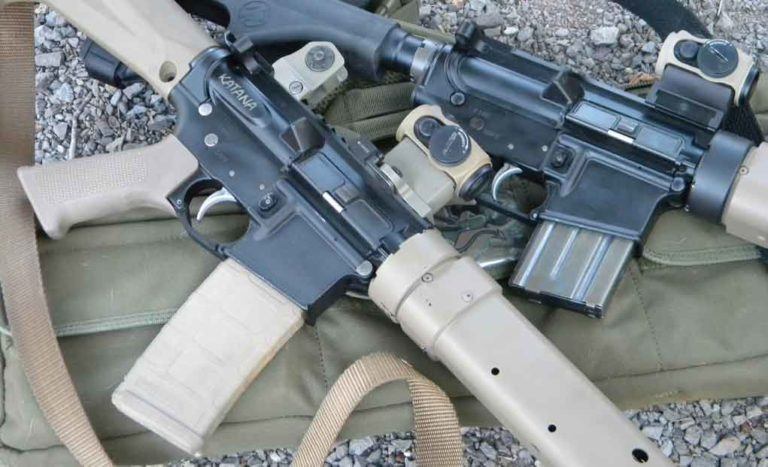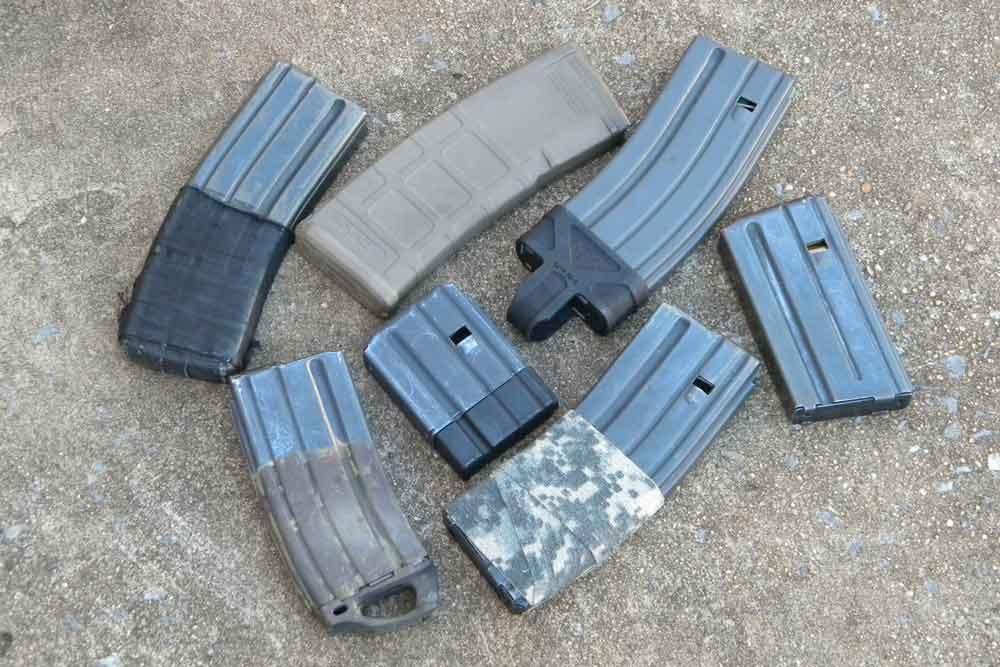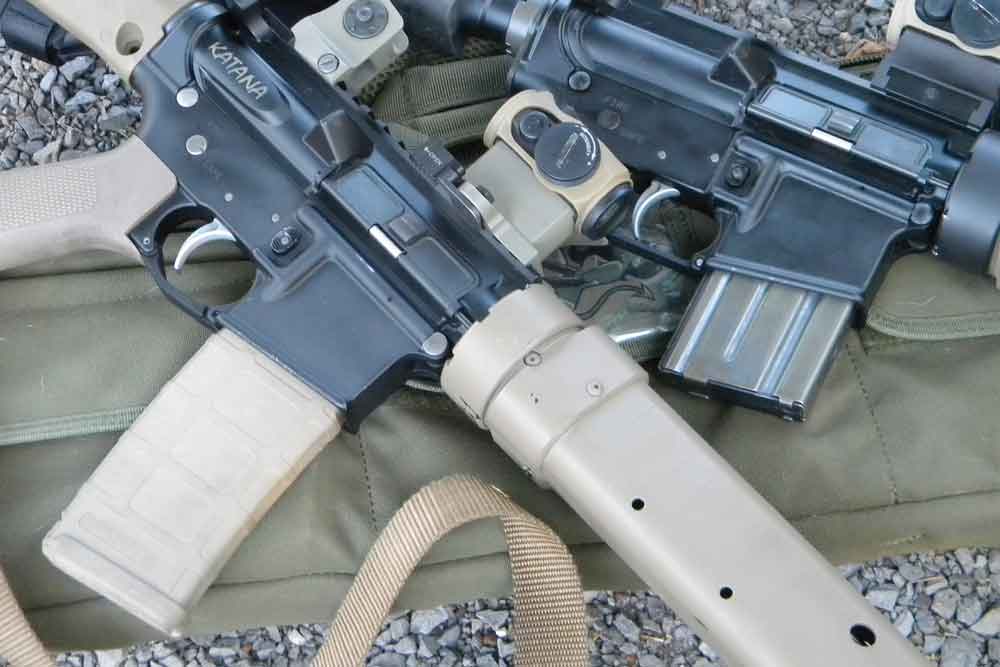
There are a few things you need to understand when it comes to AR magazines and keeping your rifle running smoothly.
The skinny on AR mags:
- Magazines have four parts: body, spring, follow and floor plate.
- All mags require regular inspection and maintenance.
- If not maintained, carbon and grime will start to build up.
- The author recommends two sets of magazines.
- One set is for practice and training magazines, the other for operational or serious work.
Magazines are an essential component to the properly functioning semi-auto firearm. You have to feed the “machine,” otherwise it won’t run reliably. Although AR magazines haven’t evolved a lot, especially compared to the rest of the AR platform, there are some tips and upgrades that make them more reliable.
This is especially true of the GI aluminum M-16/AR mags, which were originally considered disposable. We now know that with proper care these mags will last a long time.
The Making Of A Magazine

The magazine has four parts — the magazine body itself, the spring, the follower and the floor plate, which holds everything together. Mags are made from aluminum, steel and polymers … and not all are the same.
During Vietnam, a long list of companies made mags on government contracts, now referred to as “GI mags.” Some were complete rejects, and you’ll still find them in bargain bins of used mags. From this generation of GI mags, I prefer the aluminum ones and Magpul’s newest generation mags. Keep in mind that a “functioning” mag should lock in easily and drop free when you press the mag release.
The most common magazines are 20- and 30-rounders. You can also find five-, 10- and 40-round mags. Surefire offers 60- and 100-round magazines. The Beta C-Mag, a dual drum, holds 100 rounds.
Even with all that, I still use 20-round mags a lot, especially for my home defense AR. The 20s are lightweight and short. A 20-round mag creates a more compact package, but it still offers plenty of rounds. If I do need more, there are 30-rounders waiting and ready. Thirty-round mags are the “standard.” I have many that have worked well for over 3 decades and tens of thousands of rounds.
Prolonging Mag Life

I install Magpul’s “Enhanced Self-Leveling Follower” in all my 30-round GI mags. The original followers, which are usually green, will “tilt” in the mag. The front of the follower will end up lower than the rear, locking up the spring. Magpul’s follower has longer legs and is shaped, so it fits the body of the mag tighter. If you have GI 30-rounders, buy these and install them now — it’s a simple process. You can also buy magazines with Magpul followers already installed.
The other thing you need to do — regardless of what type of mag you use — is regular inspection and cleaning. The gas system of the AR will eventually create a buildup of carbon and grime inside the mag body. It can build up enough to cause feeding problems. Kleen Bore has a brush — M 206 — made specifically for scrubbing life back into AR mags.
Disassembling the mag is easy. Take a flat-blade screwdriver and insert it between the body and floor plate in the back. Gently pry the tab on the rear of the base plate so it slides out to the rear. Pull the spring out. The follower is attached to the spring, so it will come out with the spring. Once the follower reaches the bottom of the mag, you’ll have to work it out, rotating and twisting slightly to clear the shoulders that hold the base plate in position.
Clean well, and then reassemble in the reverse order. Do not use any lubricant inside the magazine. Lubricant will just attract more carbon and grime, leading to problems. Plus, the followers are made from self-lubricating material. Assemble them dry, and they’ll work fine.
If your mag is having troubles, you can “rebuild” it. There are tools to reshape the feed lips, and you can get new springs, followers and base plates. The aluminum bodies can be sanded or blasted and refinished. You can even buy new mag bodies. During the Clinton “assault” ban from 1994 to 2004, it was cheaper to rebuild mags. As I write this, mags are plentiful and affordable, so there’s not a real reason to rebuild, unless you just want a project.
How Many Mags Do You Need?

The question of how many mags you need comes up often. First of all, you need two sets of magazines. Mark them so you can tell one set from another, with the ability to identify individual magazines.
Use one set of mags for training and practice. They get abused, dropped, stepped on and all the other tortures associated with range work. Consider the other set “operational” mags, used for serious purposes like hunting, self-defense or patrol work — situations when you cannot afford a problem. Test them to ensure they function properly, but use your training mags for all of your range work.
Clint Smith always said you need one magazine for every minute it will take help to arrive. If you live in an urban area, it will take officers several minutes to arrive. Where I live, in Nowhere Alafrickingbama, it’s going to be about 20 minutes before law enforcement arrives. Will we shoot that many rounds? Not likely, but it doesn’t hurt to be prepared for the worst-case scenario.
When it comes to loading your mags, it’s always a good idea to download them less than “full.” To seat the magazine into the receiver when the bolt is closed, the bolt carrier has to press the top round down into the magazine. If there are too many rounds in the mag, it won’t lock into the receiver. With a few too many, you’ll have to bang on it to lock it in. With 25 rounds in a 30-round mag, it should lock in easily. For 20-round mags, I load 18 rounds.
How long can you leave the mag loaded without it affecting the spring? Turns out a long time — probably the rest of your life! What fatigues a spring is the constant action of being compressed and released. With today’s technology and metallurgy, a spring can be compressed a long time before taking a “set.”
So load up your magazines, put them where you can get to them, and you’ll be ready. Buy good ones, and plenty of them. Take care of them, inspecting and cleaning them regularly. With proper care, your mags will provide reliable service, and they’ll be something you can pass on to future shooters.
Editor's Note: This article originally appeared in the November 2017 issue of Gun Digest the Magazine.

Next Step: Get your FREE Printable Target Pack
Enhance your shooting precision with our 62 MOA Targets, perfect for rifles and handguns. Crafted in collaboration with Storm Tactical for accuracy and versatility.
Subscribe to the Gun Digest email newsletter and get your downloadable target pack sent straight to your inbox. Stay updated with the latest firearms info in the industry.

![Best Concealed Carry Guns In 2025 [Field Tested] Wilson Combat EDC X9S 1](https://gundigest.com/wp-content/uploads/Wilson-Combat-EDC-X9S-1-324x160.jpg)


![Best 9mm Carbine: Affordable PCCs [Tested] Ruger Carbine Shooting](https://gundigest.com/wp-content/uploads/Ruger-Carbine-Shooting-100x70.jpg)
![Best AR-15: Top Options Available Today [Field Tested] Harrington and Richardson PSA XM177E2 feature](https://gundigest.com/wp-content/uploads/Harrington-and-Richardson-PSA-XM177E2-feature-100x70.jpg)

Great article but you may recommend other high quality mags such as lancer.